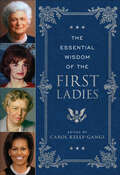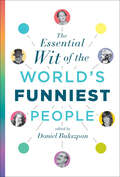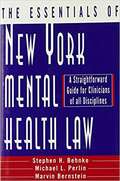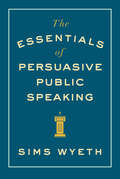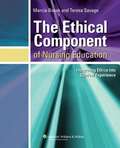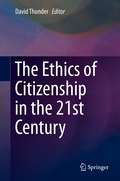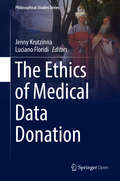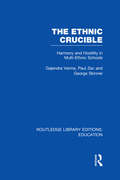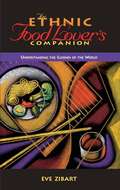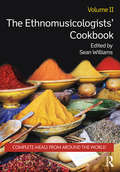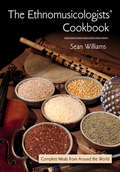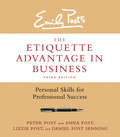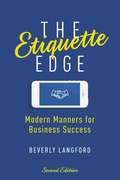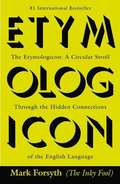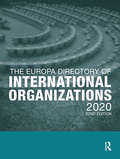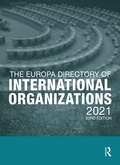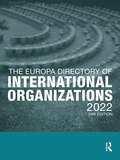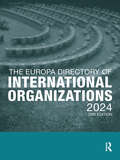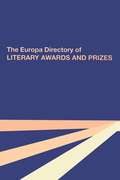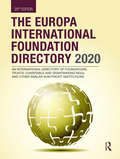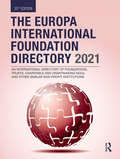- Table View
- List View
The Essential Wisdom of the First Ladies (Essential Wisdom)
by Carol Kelly-GangiInspiring, poignant, and sometimes-funny quotations by first ladies from Martha to Melania. The iconic women who’ve made an indelible mark on our country are richly represented in this collection—as are the lesser-known first ladies, whose powerful words often reveal tragic personal circumstances. The excerpts, compiled from speeches, interviews, books, letters, and other sources, are arranged thematically, touching upon a diverse array of subjects, including government and democracy; freedom, rights, equality and justice, hardship and hope; happiness, success, and life’s pleasures, and more. Together, they offer an insightful glimpse into the public and private lives of the women in the White House who have had such a profound influence on the leaders—and the historic course—of our great country.
The Essential Wisdom of the Founding Fathers (Essential Wisdom)
by Carol Kelly-GangiThoughts on patriotism, peace, politics, and more from Washington, Hamilton, Adams, Franklin, Jefferson, and others—in their own words.America’s Founding Fathers were men of words as well as deeds. Keenly intelligent and deeply committed to their ideals and to the cause for American independence, they left us a legacy of addresses and documents whose profound ideas still speak with authority. The Essential Wisdom of the Founding Fathers collects more than three hundred inspiring and instructive quotations from the men who were present at our nation’s inception. Drawn from their speeches, essays, proclamations, and declarations, the thematically arranged contents reflect the subjects of greatest import to the founders as they forged our new republic. In these selections:George Washington confides that the best way to ensure peace is to be well prepared to meet one’s enemyAlexander Hamilton warns of the dangers of limiting freedom of the pressJohn Adams reasons that true liberty cannot endure without the people’s knowledge of the character and conduct of their rulers, and moreThis volume includes extracts from texts published in the founders’ lifetimes in which they exchange ideas on the meaning of justice, the evils of slavery, the role of the patriot, and the pitfalls of politics. Here, too, are candid excerpts from correspondence in which they express fears about the perilous times they face, and their hopes for a brighter future.
The Essential Wit of the World's Funniest People
by Daniel BukszpanThis compendium of timeless wit includes jokes, aphorisms and observations from Dorothy Parker, George Carlin, Franz Kafka, Bill Murray, and many others.We’ve all heard the saying, “Everyone’s a comedian.” While that may be true, let’s face it—not everyone is funny. And even fewer are truly witty. As Daniel Bukszpan puts it in his introduction to this volume, witty saying have the ability to relate “something truthful about mankind’s folly in a matter of just a few words.” That truth-telling is the common factor that unites this collection of jokes, asides, aphorisms, and observations from some of the wittiest individuals in history. Here you’ll find everyone from W.C. Fields to H.L. Mencken, and from Margaret Cho to Ralph Waldo Emerson, offering pithy insights on subjects such as money, religion, romance, popular culture—and everything in between.
The Essentials of New York Mental Health Law: A Straightforward Guide for Clinicians of All Disciplines
by Michael L. Perlin Stephen H. Behnke Marvin BernsteinDesigned to dispel the mystery and alleviate the anxiety that many clinicians associate with the legal system, this volume surveys New York law as it applies to clinical practice and answers questions most often asked by clinicians. An indispensable guide for clinicians and students.
The Essentials of Persuasive Public Speaking
by Sims WyethA collection of short and insightful pointers on the power, potential, and practice of public speaking. Among the many pieces of expert advice in The Essentials of Persuasive Public Speaking is this nugget: "To capture attention, define a problem that keeps listeners up at night." Wyeth may as well be talking about the book itself--for nothing keeps us up at night like the prospect of giving a speech in the morning. In this portable, brief, and lucid guide to presenting, Wyeth counsels how to calm a thumping heart and reveals techniques on preparation, delivery, and visual aids as he gives you vivid stories and rubber-meets-the-road advice. And he does more than simply ease your dread; he inspires you with historical accounts and incisive observations on the power and purpose of speaking well. From advice on the pitch and pace of your speaking voice to admonishments against squirrel-paw hands and data-crammed PowerPoint slides, Wyeth's pointers will give you the focus and confidence to stand up straight, lean forward, and tell your story well.
The Ethical Component of Nursing Education: Integrating Ethics Into Clinical Experience
by Marcia Sue DeWolf Bosek Teresa A. SavageThis new primary ethics textbook is uniquely designed to integrate ethics content into the clinical nursing curriculum and to be used throughout the nursing curriculum. This textbook is designed to ensure that the nursing student benefits from a systematic coverage of clinical ethics, moving from simple ethical issues to more complex. The book covers clinical ethics in theory and practice by building upon the foundations of ethics using the traditional clinical practice content areas such as children and adolescents, adult, critical care, and women's health.
The Ethical Spirit of EU Values: Status Quo of the Union of Values and Future Direction of Travel
by Markus FrischhutThis open access book, summarising the research conducted at this Jean Monnet Chair, seeks to identify the ethical spirit of European Union (EU) values. EU integration began at the economic level; human rights were only added at a later stage. Finally, the Lisbon Treaty turned the EU into a ‘Union of values’ by enshrining certain concepts in Art 2 TEU. This provision can be seen as a hub linked to various other provisions of EU primary and secondary law. The values contained therein have, amongst others, been applied to two areas (digitalisation and non-financial reporting, partly in sports), and further specified in others (health and partly in sports). This book analyses the evolution of values (ratione temporis) and the questions of who is entitled and who is obliged (ratione personae). Besides the external perspective (ratione limitis; e.g., Brexit), it focuses on the composition of the EU’s common values (ratione materiae). As Art 2 TEU can be viewed as a hub, it is essential to focus on various relations, not only between values, but also between values and other provisions of EU law, as well as other concepts. Based on this description of the status quo, the book subsequently addresses a possible future direction, arguing for an additional narrative (trust), an additional value (environmental protection), and a more communitarian Union. In closing, apart from the classical commitment of the EU and the Member States to uphold the values of the EU, the book discusses the level of individuals and values as virtues. Various figures and tables complement this overview of the status quo of the Union of values and outline of its future direction.
The Ethics of Artificial Intelligence for the Sustainable Development Goals (Philosophical Studies Series #152)
by Luciano Floridi Francesca MazziThis volume provides an extensive overview of the Ethics of Artificial Intelligence for the Sustainable Development Goals. The authors are experts contributing with perspectives from different fields. The comprehensive collection of chapters illustrates the pressing governance problems related to using AI for the SDGs, and case studies describing how AI is advancing and can advance the achievement of the Goals. Students, scholars, and practitioners working on AI for SDGs, the ethical governance of AI, sustainability, and the fourth revolution can find this book a helpful reference.
The Ethics of Citizenship in the 21st Century
by David ThunderThis collection of essays offers thoughtful discussions of major challenges confronting the theory and practice of citizenship in a globalized, socially fragmented, and multicultural world. The traditional concept of citizenship as a shared ethnic, religious, and/or cultural identity has limited relevance in a multicultural world, and even the connection between citizenship and national belonging has been put in jeopardy by increasing levels of international migration and mobility, not to mention the pervasive influence of a global economy and mass media, whose symbols and values cut across national boundaries. Issues addressed include the ethical and practical value of patriotism in a globalized world, the standing of conscience claims in a morally diverse society, the problem of citizen complicity in national and global injustice, and the prospects for a principled acceptance by practising Muslims of a liberal constitutional order. In spite of the impressive diversity of philosophical traditions represented in this collection, including liberalism, pragmatism, Confucianism, Platonism, Thomism, and Islam, all of the volume’s contributors would agree that the crisis of modern citizenship is a crisis of the ethical values that give shape, form, and meaning to modern social life. This is one of the few edited volumes of its kind to combine penetrating ethical discussion with an impressive breadth of philosophical traditions and approaches.Chapters “What is the use of an Ethical Theory of Citizenship?” and “An Ethical Defense of Citizenship” are available open access under a Creative Commons Attribution 4.0 International License via link.springer.com.
The Ethics of Medical Data Donation (Philosophical Studies Series #137)
by Luciano Floridi Jenny KrutzinnaThis open access book presents an ethical approach to utilizing personal medical data. It features essays that combine academic argument with practical application of ethical principles. The contributors are experts in ethics and law. They address the challenges in the re-use of medical data of the deceased on a voluntary basis. This pioneering study looks at the many factors involved when individuals and organizations wish to share information for research, policy-making, and humanitarian purposes. Today, it is easy to donate blood or even organs, but it is virtually impossible to donate one’s own medical data. This is seen as ethically unacceptable. Yet, data donation can greatly benefit the welfare of our societies. This collection provides timely interdisciplinary research on biomedical big data. Topics include the ethics of data donation, the legal and regulatory challenges, and the current and future collaborations. Readers will learn about the ethical and regulatory challenges associated with medical data donations. They will also better understand the special nature of using deceased data for research purposes with regard to ethical principles of autonomy, beneficence, and justice. In addition, the contributors identify the key governance issues of such a scheme. The essays also look at what we can learn in terms of best practice from existing medical data schemes.
The Ethics of Tax Evasion
by Robert W. McgeeWhy do people evade paying taxes? This is the central question addressed in this volume by Robert McGee and a multidisciplinary group of contributors from around the world. Applying insights from economics, public finance, political science, law, philosophy, theology and sociology, the authors consider the complex motivations for not paying taxes and the conditions under which this behavior might be rationalized. Applying theoretical approaches as well as empirical research, The Ethics of Tax Evasion considers three general arguments for tax evasion: (1) in cases where the government is corrupt or engaged in human rights abuses; (2) where citizens claim inability to pay, unfairness in the tax system, paying for things that do not benefit the taxpayer, excessively high tax rates, or where taxes are used to support an unpopular war; and (3) through philosophical, moral, or religious opposition. The authors further explore these issues by asking whether attitudes toward tax evasion differ by country or other demographic variables such as gender, age, ethnicity, income level, marital status, education or religion. The result is a multi-faceted analysis of tax evasion in cultural and institutional context, and, more generally, a study in ethical dilemmas and rational decision making.
The Ethnic Crucible: Harmony and Hostility in Multi-Ethnic Schools (Routledge Library Editions: Education)
by Gajendra Verma Paul Zec George SkinnerMany schools in developed countries have children and adolescents from a variety of ethnic, linguistic, religious and cultural backgrounds. They relate to each other in various degrees of encounter that range from harmony to hostility. The issue of how a school can foster inter-ethnic relationships and challenge the manifestations of bad relationships cannot of course be divorced from tensions and inequalities in the wider society. This book focuses on ways in which schools might make a difference to the quality of such relationships within their walls. It has sought to do this by studying nine secondary schools in some depth: their organisation, structures and interactive processes: and the experiences, attitudes and behaviour of students and their teachers. The research on which the book is based has also yielded data on the influence of policy and procedure in schools on relationships.
The Ethnic Food Lover's Companion
by Eve ZibartNowhere is America's rich ethnic and cultural diversity more apparent than in its restaurants. Every city and region of the United States has a unique cultural heritage - whether it's Cuban, Thai, Spanish, Italian, Indian, French or German - reflected in its dining choices. So what do you order in an ethnic restaurant, and how do you eat? The Ethnic Food Lover's Companion provides all the information you need to make every ethnic dining experience a pleasant and memorable one. In this book you will find information about what to expect in any type of ethnic restaurant; detail profiles of each ethnic cuisine, including key ingredients, spices and methods of preparation; cultural tips to put you at ease with the customs and etiquette of each cuisine; representative dishes of each cuisine defined and described; recommended complete meals from appetizer through dessert and easy recipes you can prepare at home.
The Ethnomusicologists' Cookbook, Volume II: Complete Meals from Around the World
by Sean WilliamsThis companion to The Ethnomusicologists' Cookbook combines scholarship with a unique approach to the study of the world's foods, musics, and cultures. Covering over four dozen regions, the entries in these collection each include a regional food-related proverb, a recipe for a complete meal, a list of companion readings and listening pieces, and a short essay that highlights the significant links between music and food in the area. The Ethnomusicologists' Cookbook, Volume 2 will appeal to ethnomusicologists, anthropologists, and sociologists, but should also find a welcome place on the bookshelf of anyone who enjoys eating and learning about foods from around the world.
The Ethnomusicologists' Cookbook: Complete Meals from Around the World
by Sean WilliamsNamed one of New York Times Top-20 Cookbooks of 2006. Have you ever wanted to host a full evening of Indian food, culture, and music? How about preparing a traditional Balinese banquet? Or take a trip to Cairo and enjoy an Egyptian feast? The Ethnomusicologists' Cookbook takes you around the world on a culinary journey that is also a cultural and social odyssey. Many cookbooks offer a snapshot of individual recipes from different parts of the world, but do nothing to tell the reader how different foods are presented together, or how to relate these foods to other cultural practices. For years, ethnomusicologists have visited the four corners of the earth to collect the music and culture of native peoples, from Africa to the Azores, from Zanzibar to New Zealand. Along the way, they've observed how music is an integral part of social interaction, particularly when it's time for a lavish banquet or celebration. Foodways and cultural expression are not separate; this book emphasizes this connection through offering over thirty-five complete meals, from appetizers to entrees to side dishes to desserts and drinks. A list of recommended CDs fills out the culinary experience, along with hints on how to present each dish and to organize the overall meal. The Ethnomusicologists' Cookbook combines scholarship with a unique and fun approach to the study of the world's foods, musics, and cultures. More than just a cookbook, it is an excellent companion for anyone embarking on a cultural-culinary journey.
The Etiquette Advantage in Business, Third Edition
by Peter Post Anna Post Lizzie Post Daniel Post SenningYour key to professional and personal successCompletely revised and updated, the third edition of the Posts' The Etiquette Advantage in Business is the ultimate guide professionals need to build successful business relationships with confidenceToday, more than ever, good manners mean good business. The Etiquette Advantage in Business offers proven, essential advice, from resolving conflicts with ease and grace to building productive relationships with colleagues at all levels. It also offers up-to-date guidance on important professional skills, including ethics, harassment in the workplace, privacy, networking, email, social media dos and don'ts, and knowing how and when to take responsibility for mistakes.For the first time in business history, four distinct generations inhabit the workplace at the same time, leading to generational differences that can cause significant tensions and relationship problems. The Etiquette Advantage in Business aims to help navigate conflict by applying consideration, respect, and honesty to guide you safely through even the most difficult situations.Written for professionals from diverse backgrounds and fields, The Etiquette Advantage in Business remains the definitive resource for timeless advice on business entertaining and dining etiquette, written communications, appropriate attire for any business occasion, conventions and trade shows, job searches and interviews, gift-giving, overseas travel, and more.In today's hyper-competitive workplace, knowing how to get along can make the difference between getting ahead and getting left behind. The Etiquette Advantage in Business provides critical tools for building solid, productive relationships and will help you meet the challenges of the work world with confidence and poise.
The Etiquette Edge: The Unspoken Rules for Business Success
by Beverly LangfordIntelligence, ambition, and skill will start you on the road to success, but without strong communications skills, social savvy, and a sense of appropriate behavior...you won't get far.The Etiquette Edge gives you a crash course on modern business manners. New advice explains how to navigate sticky situations at work, including digital interactions that are easy to misinterpret--and hard to mend. From interviewing etiquette and dress codes to working in close quarters and communicating upward, you'll master the essentials of making a great impression and building relationships, including how to:Be smart about how--and when--you use your smartphoneHandle difficult conversations with tact and finesseCheck texts and emails for content and toneCreate a polished image on social mediaConduct meetings (in person, online, or over lunch) with poise and confidenceAnd moreIn our era of entitlement, saying thank-you and giving praise are increasingly rare--but these simple acts are far from empty gestures. They're refreshing reflections of respect. Inconsiderate people and poor conduct may permeate the workplace, but success comes to those who play by a better set of rules.
The Etymologicon
by Mark ForsythDo you know why... ...a mortgage is literally a death pledge? ...why guns have girls' names? ...why salt is related to soldier? You're about to find out... The Etymologicon (e-t?-'mä-lä-ji-kän) is: *Witty (wi-te\): Full of clever humor *Erudite (er-?-dit): Showing knowledge *Ribald (ri-b?ld): Crude, offensive The Etymologicon is a completely unauthorized guide to the strange underpinnings of the English language. It explains: how you get from "gruntled" to "disgruntled"; why you are absolutely right to believe that your meager salary barely covers "money for salt"; how the biggest chain of coffee shops in the world (hint: Seattle) connects to whaling in Nantucket; and what precisely the Rolling Stones have to do with gardening.
The Europa Directory of International Organizations 2020
by Europa PublicationsThe Europa Directory of International Organizations 2020 serves as an unequalled one-volume guide to the contemporary international system. Within a clear, unique framework the recent activities of all major international organizations are described in detail. Given alongside extensive background information the reader is able to assess the role and evolving functions of these organizations in today's world. The contact details, key personnel and activities of more than 2,000 international and regional entities have again been thoroughly researched and updated for this 20th edition. Highlights in this edition include: - a fully revised Who's Who section with biographical details of the key players in the international system. - the response of the international community to crises and conflicts throughout the world. - introductory essays, written and updated by experts in their field, which consider topics including global environmental governance, the international criminal justice system, international humanitarian co-operation, and governance of the global economy.
The Europa Directory of International Organizations 2021
by Helen CantonThe Europa Directory of International Organizations 2021 serves as an unequalled one-volume guide to the contemporary international system. Within a clear, unique framework the recent activities of all major international organizations are described in detail. Given alongside extensive background information the reader is able to assess the role and evolving functions of these organizations in today's world. The contact details, key personnel and activities of more than 2,000 international and regional entities have again been thoroughly researched and updated for this 23rd edition. Highlights in this edition include: - a fully revised Who's Who section with biographical details of the key players in the international system. - the response of the international community to crises and conflicts throughout the world. - specially-commissioned introductory essays cover topics including global environmental governance, transboundary water management, and multilateral governance and global action on health.
The Europa Directory of International Organizations 2022
by Helen CantonThe Europa Directory of International Organizations 2022 serves as an unequalled one-volume guide to the contemporary international system. Within a clear, unique framework the recent activities of all major international organizations are described in detail. Given alongside extensive background information the reader is able to assess the role and evolving functions of these organizations in today's world. The contact details, key personnel and activities of more than 2,000 international and regional entities have again been thoroughly researched and updated for this 24th edition. Highlights in this edition include: - a fully revised Who's Who section with biographical details of the key players in the international system. - the response of the international community to crises and conflicts throughout the world. - specially-commissioned introductory essays cover topics including global environmental governance, transboundary water management, and multilateral governance and global action on health.
The Europa Directory of International Organizations 2024 (The Europa Directory of International Organizations)
The Europa Directory of International Organizations 2024 serves as an unequalled one-volume guide to the contemporary international system.Within a clear, unique framework the recent activities of all major international organizations are described in detail. Given alongside extensive background information the reader is able to assess the role and evolving functions of these organizations in today's world.The contact details, key personnel and activities of more than 2,000 international and regional entities have again been thoroughly researched and updated for this 25th edition.Highlights in this edition include:- a fully revised Who's Who section with biographical details of the key players in the international system.- the response of the international community to crises and conflicts throughout the world.- specially-commissioned introductory essays cover topics including global environmental governance, transboundary water management, and multilateral governance and global action on health.
The Europa Directory of Literary Awards and Prizes
by Susan LeckeyA complete guide to the major awards and prizes of the literary world.* An invaluable source of information on awards and prizes world-wide* Covers over 1,000 awards and prizes* Comprehensive background information on each award* Extensive contact details.Contents* Includes internationally awarded prizes along with prestigious national awards* Subject areas covered include adult and children's fiction, non-fiction, poetry, lifetime's achievement, translation and drama* Information is provided on the history of each award, its purpose, what is awarded, how often the prize is awarded, eligibility and restrictions, the awarding organization and the most recent recipients* Full contact details of the awarding organization are provided, including main contact name, postal address, e-mail and Internet address, telephone and fax numbers* Fully indexed by keyword, awarding organization and award by subject.
The Europa International Foundation Directory 2020 (The\europa International Foundation Directory Ser.)
by Cathy HartleyNow in its 29th edition, the Europa International Foundation Directory 2020 provides an unparalleled guide to the foundations, trusts, charitable and grantmaking NGOs, and other similar not-for-profit organizations of the world. It provides a comprehensive picture of third sector activity on a global scale. Users will find names and contact details for some 2,690 institutions worldwide. This new edition has been revised and expanded to include the most comprehensive and up-to-date information on this growing sector. Indexes allow the reader to find organizations by area of activity (including conservation and the environment, science and technology, education and social welfare) and geographical region of operations (e.g. South America, Central America and the Caribbean, Australasia, Western Europe and North America). Contents include: A comprehensive directory section organized by country or territory; Details of co-ordinating bodies, and of foundations, trusts and non-profit organizations; A full index of organizations, and indexes by main activity and by geographical area of activity.
The Europa International Foundation Directory 2021
by Cathy HartleyNow in its 30th edition, the Europa International Foundation Directory 2021 provides an unparalleled guide to the foundations, trusts, charitable and grantmaking NGOs, and other similar not-for-profit organizations of the world. It provides a comprehensive picture of third sector activity on a global scale. Users will find names and contact details for some 2,690 institutions worldwide. This new edition has been revised and expanded to include the most comprehensive and up-to-date information on this growing sector. Indexes allow the reader to find organizations by area of activity (including conservation and the environment, science and technology, education and social welfare) and geographical region of operations (e.g. South America, Central America and the Caribbean, Australasia, Western Europe and North America). Contents include: A comprehensive directory section organized by country or territory; Details of co-ordinating bodies, and of foundations, trusts and non-profit organizations; A full index of organizations, and indexes by main activity and by geographical area of activity.
